Impact of Biohybrid Magnetite Nanoparticles and Moroccan Propolis on Adherence of Methicillin Resistant Strains of Staphylococcus aureus
Abstract
:1. Introduction
2. Results
2.1. Chemical Composition of Propolis Extract
2.2. Characterization of the Nanomaterial
2.2.1. X-ray diffraction (XRD)
2.2.2. TEM
2.2.3. Mössbauer Spectroscopy
2.2.4. Fourrier Tranform Infrared Spectroscopy (FTIR)
2.3. Impact of the Nanoparticles on Bacterial Adherence
3. Discussion
4. Materials and Methods
4.1. Chemicals and Reagents
4.2. Propolis Extract
4.3. GC-MS Analysis of Propolis Extract
4.4. Preparation of Magnetite Nanoparticles
4.4.1. Method #1
4.4.2. Method #2
4.4.3. Method #3
4.5. Preparation of Functionalized Magnetite Nanoparticles
4.6. Synthesis of A Hybrid Core/Shell/Coated Shell Nanomaterial
4.7. Characterization of the Nanomaterial
4.7.1. XRD
4.7.2. TEM
4.7.3. Mossbauer Spectroscopy
4.7.4. FTIR
4.8. Impact of the Nanoparticles on Bacterial Adherence
4.9. Statistical Analysis
5. Conclusions
Acknowledgments
Author Contributions
Conflicts of Interest
References
- Burdock, G.A. Review of the biological properties and toxicity of bee propolis (propolis). Food Chem. Toxicol. 1998, 36, 347–363. [Google Scholar] [CrossRef]
- Barlak, Y.; Deger, O.; Çolak, M.; Karatayh, S.C.; Bozdayi, A.M.; Yücesan, F. Effect of Turkish propolis extracts on proteome of prostate cancer cell line. Proteome Sci. 2011, 9. [Google Scholar] [CrossRef] [PubMed]
- Sforcin, J.M. Biological properties and therapeutic applications of propolis. Phytother. Res. 2016, 30, 894–905. [Google Scholar] [CrossRef] [PubMed]
- Wertheim, H.F.L.; Vos, M.C.; Ott, A.; van Belkum, A.; Voss, A.; Kluytmans, J.A.J.W.; van Keulen, P.H.J.; Vandenbroucke, C.M.J.E.; Meester, M.H.M.; Verbrugh, H.A. Risk and outcome of nosocomial Staphylococcus aureus bacteraemia in nasal carriers versus non-carriers. Lancet 2004, 364, 703–705. [Google Scholar] [CrossRef]
- Rybak, M.J.; LaPlante, K.L. Community-associated methicillin-resistant Staphylococcus aureus: A review. Pharmacotherapy 2005, 25, 74–85. [Google Scholar] [CrossRef] [PubMed]
- Frank, D.N.; Feazel, L.M.; Bessesen, M.T.; Price, C.S.; Janoff, E.N.; Pace, N.R. The human nasal microbiota and Staphylococcus aureus carriage. PLoS ONE 2014, 5, e10598. [Google Scholar] [CrossRef] [PubMed]
- Chambers, H.F.; DeLeo, F.R. Waves of resistance: Staphylococcus aureus in the antibiotic era. Nat. Rev. Microbiol. 2009, 7, 629–641. [Google Scholar] [CrossRef] [PubMed]
- Huang, C.M.; Chen, C.H.; Pornpattananangkul, D.; Zhang, L.; Chan, M.; Hsieh, M.F.; Zhang, L. Eradication of drug resistant Staphylococcus aureus by liposomal oleic acids. Biomaterials 2011, 32, 214–221. [Google Scholar] [CrossRef] [PubMed]
- Magana, M.; Ioannidis, A.; Magiorkinis, E.; Ursu, O.; Bologa, C.G.; Chatzipanagiotou, S.; Hamblin, M.R.; Tegos, G.P. Therapeutic options and emerging alternatives for multidrug resistant Staphylococcus infections. Curr. Pharm. Des. 2015, 21, 2058–2072. [Google Scholar] [CrossRef] [PubMed]
- Wojtyczka, R.D.; Dziedzic, A.; Idzik, D.; Kepa, M.; Kubina, R.; Kabala-Dzik, A.; Smolén-Dzirba, J.; Stjko, J.; Sajewicz, M.; Wasik, T.J. Susceptibility of Staphylococcus aureus clinical isolates to propolis extract alone or in combination with antimicrobial drugs. Molecules 2013, 18, 9623–9640. [Google Scholar] [CrossRef] [PubMed]
- Cartelle, G.M.; Holban, A.M. Advances in nanotechnology as an alternative against superbags. JSM Chem. 2014, 2, 1011. [Google Scholar]
- Chifiriuc, C.; Grumezescu, V.; Grumezescu, A.M.; Saviuc, C.; Lazăr, V.; Andronescu, E. Hybrid magnetite nanoparticles/Rosmarinus officinalis essential oil nanobiosystem with antibiofilm activity. Nanoscale Res. Lett. 2012, 7. [Google Scholar] [CrossRef] [PubMed]
- Liakos, I.; Grumezescu, A.M.; Holban, A.M. Magnetite nanostructures as novel strategies for anti-infections therapy. Molecules 2014, 19, 12710–12726. [Google Scholar] [CrossRef] [PubMed]
- Wu, W.; He, Q.; Jiang, C. Magnetic iron oxide nanoparticles: Synthesis and surface functionalization strategies. Nanoscale Res. Lett. 2008, 3, 397–415. [Google Scholar] [CrossRef] [PubMed]
- Anghel, I.; Grumezescu, A.M.; Andronescu, E.; Anghel, A.G.; Ficai, A.; Saviuc, C.; Grumezescu, V.; Vasile, B.S.; Chifiriuc, M.C. Magnetite nanoparticles for functionalized textile dressing to prevent fungal biofilms development. Nanoscale Res. Lett. 2012, 7, 501. [Google Scholar] [CrossRef] [PubMed]
- Poiată, A.; Tuchilus, C.; Creangă, D.; Stan, C. Magnetic nanoparticles influence on some bacterial cultures. Rom. J. Biophys. 2013, 23, 203–209. [Google Scholar]
- Boisard, S.; Le Ray, A.M.; Landreau, A.; Kempf, M.; Cassisa, V.; Flurin, C.; Richomme, P. Antifungal and antibacterial metabolites from a French poplar type propolis. Evid. Based Complement. Altern. Med. 2015, 2015. [Google Scholar] [CrossRef] [PubMed]
- Astani, A.; Zimmermann, S.; Hassan, E.; Reichling, J.; Sensch, K.H.; Schnitzler, P. Antimicrobial activity of propolis special extract GH2002 against multidrug-resistant clinical isolates. Pharmazie 2013, 68, 695–701. [Google Scholar] [PubMed]
- Pamplona-Zomenhan, L.C.; Pamplona, B.C.; Silva, C.B.; Marcucci, M.C.; Mímica, L.M.J. Evaluation of the in vitro antimicrobial activity of an ethanol extract of Brazilian classified propolis on strains of Staphylococcus aureus. Braz. J. Microbiol. 2011, 42, 1259–1264. [Google Scholar] [PubMed]
- Darwish, R.M.; Fares, R.J.A.; Zarga, M.H.A.; Nazer, I.K. Antibacterial effect of Jordanian propolis and isolated flavonoids against human pathogenic bacteria. Afr. J. Bacteriol. 2010, 9, 5966–5974. [Google Scholar]
- Raghukumar, R.; Vali, L.; Watson, D.; Fearnley, J.; Seidel, V. Antimethicillin-resistant Staphlylococcus aureus (MRSA) activity of ‘Pacific propolis’ and isolated prenylflavanones. Phytother. Res. 2010, 24, 1181–1187. [Google Scholar] [PubMed]
- Onlen, Y.; Duran, N.; Atik, E.; Savas, L.; Altug, E.; Yakan, S.; Aslantas, O. Antibacterial activity of propolis against MRSA and synergism with topical mupirocin. J. Altern. Complement. Med. 2007, 13, 713–718. [Google Scholar] [CrossRef] [PubMed]
- Pepeljnjak, S.; Kosalec, I. Galangin expresses bactericidal activity against multiple-resistant bactéria: MRSA, Enterococcus spp. and Pseudomonas aeruginosa. FEMS Microbiol. Lett. 2004, 240, 111–116. [Google Scholar] [CrossRef] [PubMed]
- Huang, S.; Zhang, C.P.; Wang, K.; Li, G.Q.; Hu, F.L. Recent advances in the chemical composition of propolis. Molecules 2014, 19, 19610–19632. [Google Scholar] [CrossRef] [PubMed]
- Popova, M.; Lyoussi, B.; Aazza, S.; Antunes, D.; Bankova, V.; Miguel, G. Antioxidant and α-glucosidase inhibitory properties and chemical profiles of Moroccan propolis. Nat. Prod. Commun. 2015, 10, 1961–1964. [Google Scholar] [PubMed]
- Paramês, M.L.; Mariano, J.; Viskadourakis, Z.; Popovici, N.; Rogalski, M.S.; Giapintzakis, J.; Conde, O. PLD of Fe3O4 thin films: Influence of background gas on surface morphology and magnetic properties. Appl. Surf. Sci. 2006, 252, 4610–4614. [Google Scholar] [CrossRef]
- Mahdavi, M.; Ahmad, M.B.; Haron, M.J.; Namvar, F.; Nadi, B.; Rahman, M.Z.A.; Amin, J. Synthesis, surface modification and characterisation of biocompatible magnetic iron oxide nanoparticles for biomedical applications. Molecules 2013, 18, 7533–7548. [Google Scholar] [CrossRef] [PubMed]
- Lawaczeck, R.; Menzel, M.; Pietsch, H. Superparamagnetic iron oxide particles: Contrast media for magnetic resonance imaging. Appl. Organomet. Chem. 2004, 18, 506–513. [Google Scholar] [CrossRef]
- Casillas, P.E.G.; Gonzalez, C.A.R.; Pérez, C.A.M. Infrared spectroscopy of functionalized magnetic nanoparticles. In Infrared Spectroscopy—Materials Science, Engineering and Technology; Theophanides, T., Ed.; InTech: Rijeka, Croatia, 2012; pp. 405–420. [Google Scholar]
- Yang, K.; Peng, H.; Wen, Y.; Li, N. Re-examination of characteristic FTIR spectrum of secondary layer in bilayer oleic acid-coated Fe3O4 nanoparticles. Appl. Surf. Sci. 2010, 256, 3093–3097. [Google Scholar] [CrossRef]
- Ma, M.; Zhang, Y.; Yu, W.; Shen, H-y.; Zhang, H-q.; Gu, N. Preparation and characterization of magnetite nanoparticles coated by amino silane. Colloids Surf. A Physicochem. Eng. Asp. 2003, 212, 219–226. [Google Scholar] [CrossRef]
- Chifiriuc, C.; Lazăr, V.; Bleotu, C.; Călugărescu, I.; Grumezescu, A.M.; Mihaiescu, D.E.; Mogosanu, D.E.; Buteică, A.S.; Buteică, E. Bacterial adherence to the cellular and inert substrate in the presence of CoFe2O4 and Fe3O4/oleic acid-core/shell. Dig. J. Nanomater. Biostruct. 2011, 6, 37–42. [Google Scholar]
- Asawahame, C.; Sutjarittangtham, K.; Eitssayeam, S.; Tragoolpua, Y.; Sirithunyalug, B.; Sirithunyalug, J. Antibacterial activity and inhibition of adherence of Streptococcus mutans by propolis electrospun fibers. AAPS PharmSciTech 2015, 16, 182–191. [Google Scholar] [CrossRef] [PubMed]
- Veloz, J.J.; Saavedra, N.; Lillo, A.; Alvear, M.; Barrientos, L.; Salazar, L.A. Antibiofilm activity of Chilean propolis on Streptococcus mutans is influenced by the year of collection. BioMed Res. Int. 2015, 2015. [Google Scholar] [CrossRef] [PubMed]
- Stan, T.; Mărutescu, L.; Chifiriuc, M.C.; Lazăr, V. Anti-pathogenic effect of propolis extracts from different Romanian regions on Staphylococcus sp. Clinical strains. Rom. Biotechnol. Lett. 2016, 21, 11166–11175. [Google Scholar]
- Kang, Y.S.; Rabolt, J.F.; Risbud, S.; Stroeve, P. Synthesis and characterization of nanometer-size Fe3O4 and γ-Fe2O3 particles. Chem. Mater. 1996, 8, 2209–2211. [Google Scholar] [CrossRef]
- Qu, S.; Yang, H.; Ren, D.; Kan, S.; Zou, G.; Li, D. Magnetite nanoparticles prepared by precipitation from partially reduced ferric chloride aqueous solutions. J. Colloid Interface Sci. 1999, 215, 190–192. [Google Scholar] [CrossRef] [PubMed]
- Xuan, S.; Hao, L.; Jiang, W.; Gong, X.; Hu, Y.; Chen, Z. Preparation of water-soluble magnetite nanocrystals through hydrothermal approach. J. Magn. Magn. Mater. 2007, 308, 210–213. [Google Scholar] [CrossRef]
- Foca-nici; Ciurlica, E.L.; Nadejde, C.; Creanga, D.E.; Carlescu, A.; Badescu, V. Antibiotic Coated Magnetite Nanoparticles for Biological Applications. Available online: http://www.jscimedcentral.com/Chemistry/chemistry-2-1011.pdf (accessed on 3 April 2016).
- Prisecaru, I. WMOSS4 Mössbauer Spectral Analysis Software. 2016. Available online: http://www.wmoss.org (accessed on 5 February 2016).
- Miles, A.A.; Misra, S.S. The estimation of the bactericidal power of blood. J. Hyg. (London) 1938, 38, 732–749. [Google Scholar] [CrossRef]
- Sample Availability: Samples of the compounds from the authors are not available.
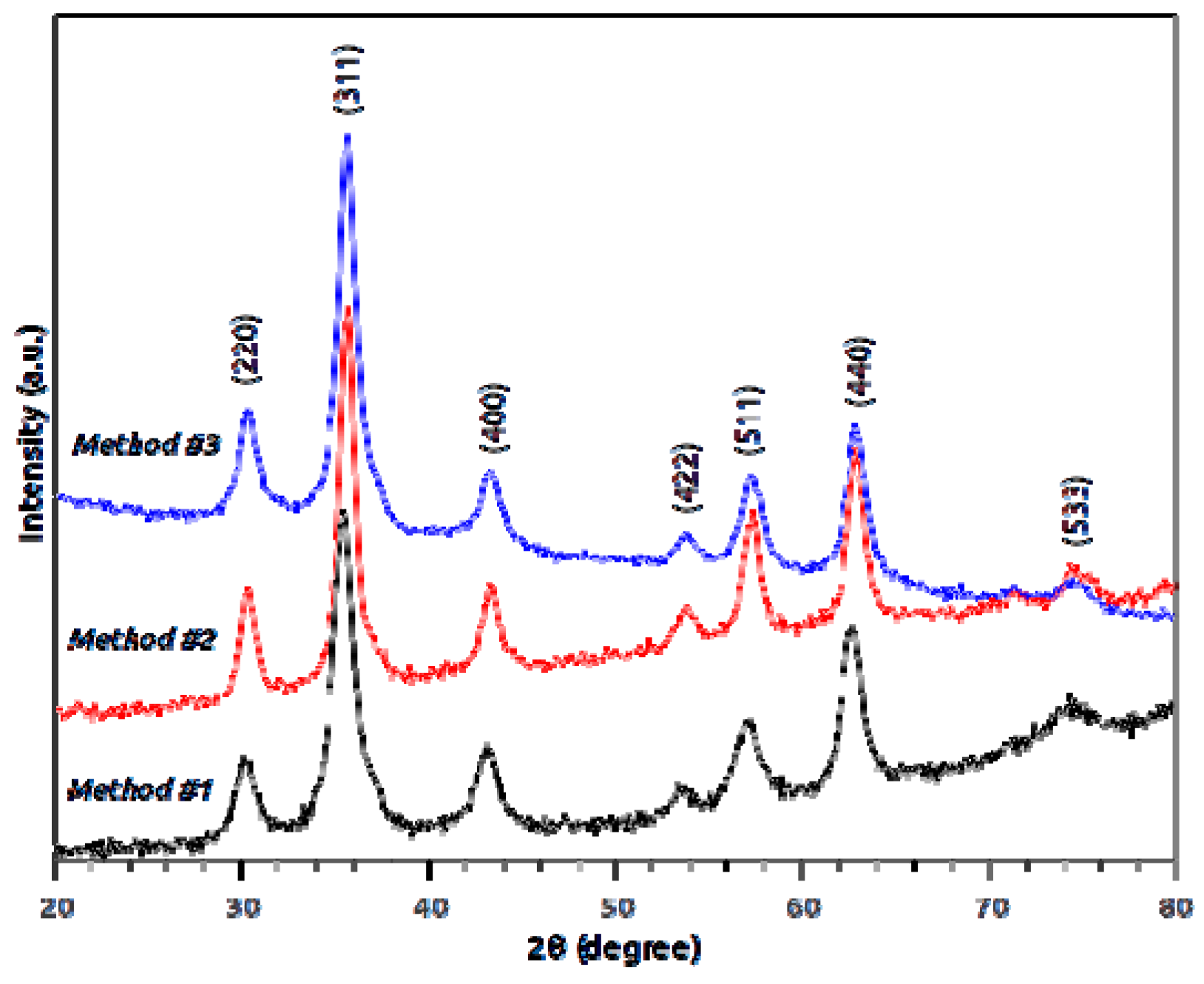

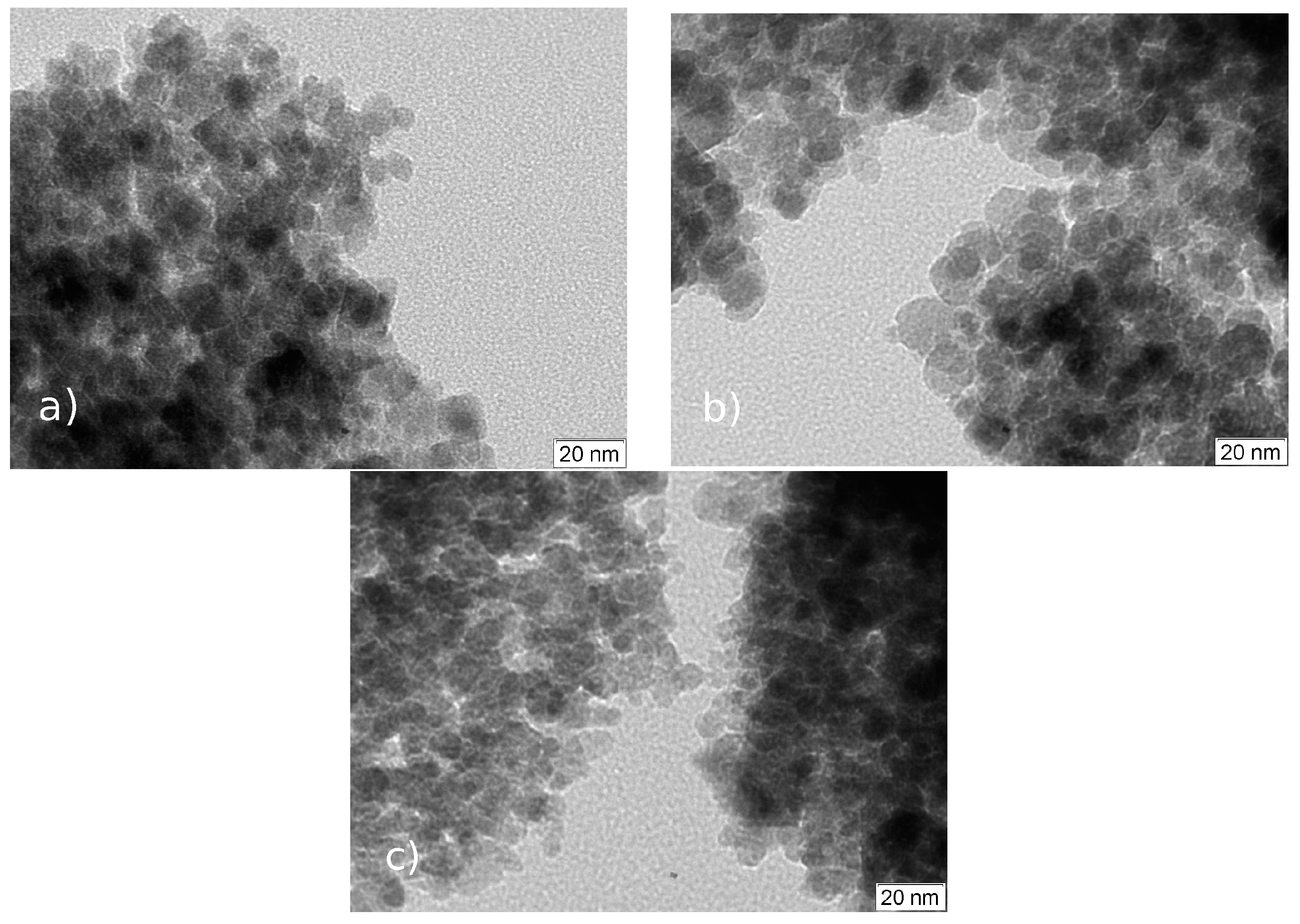
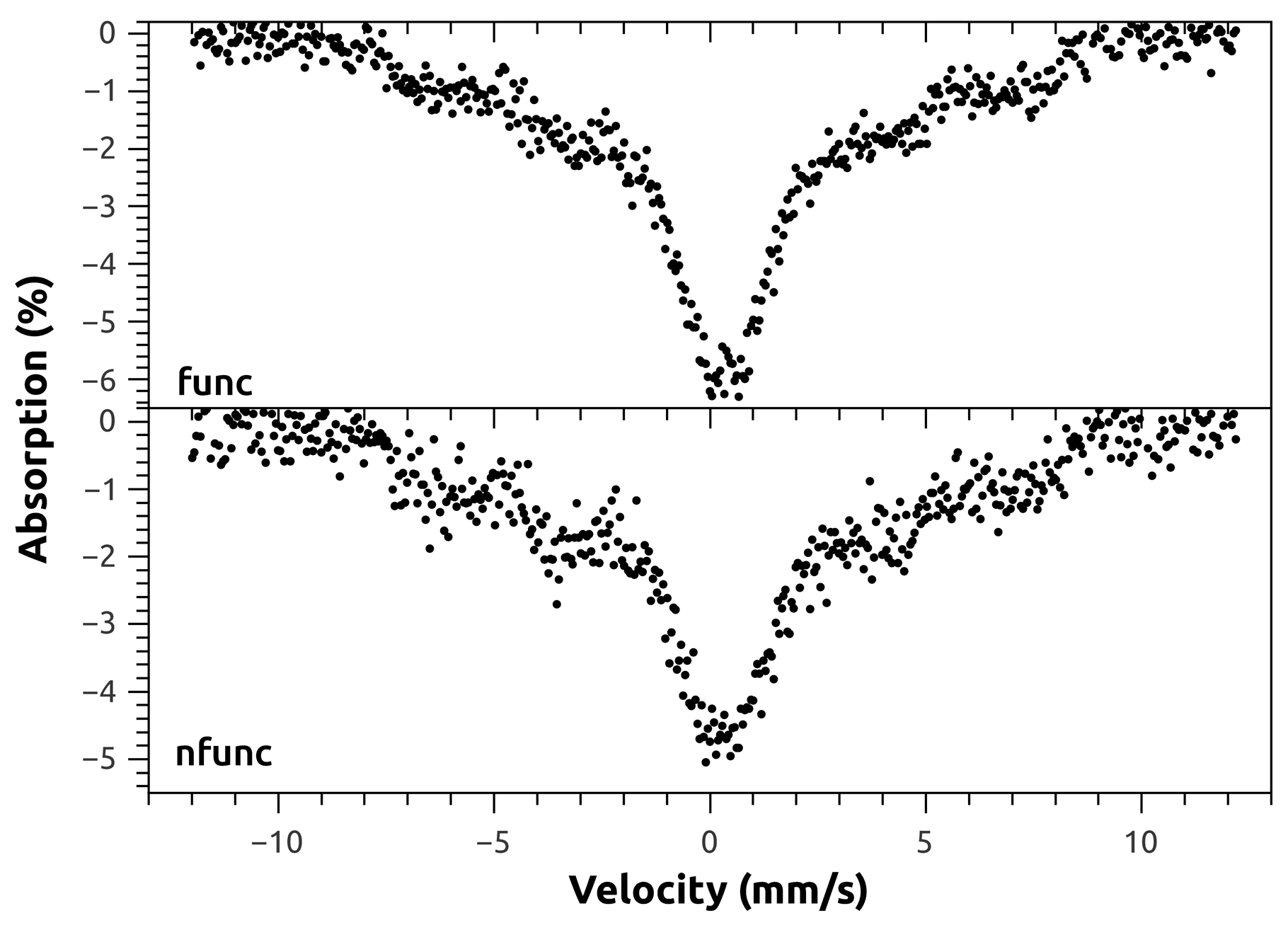
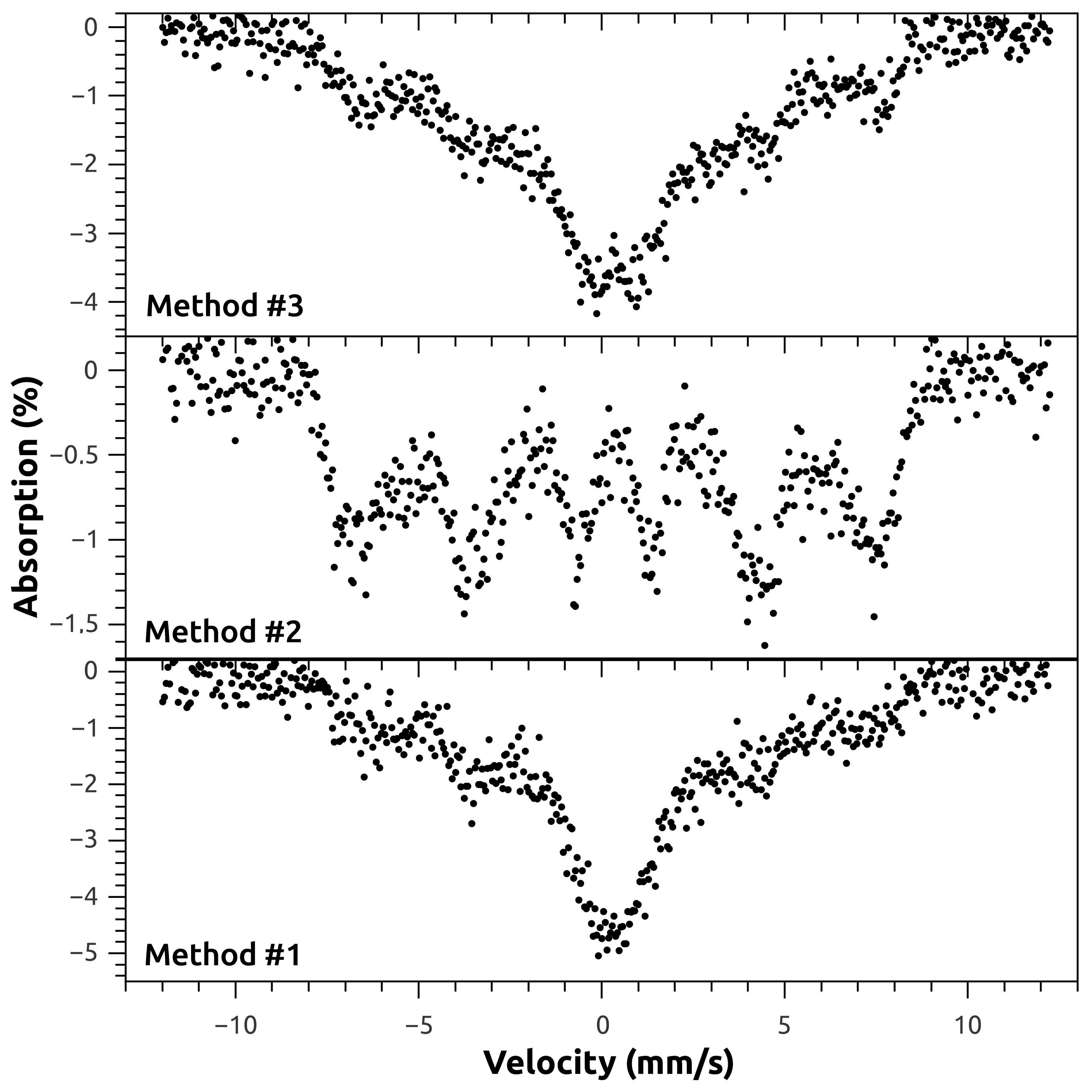

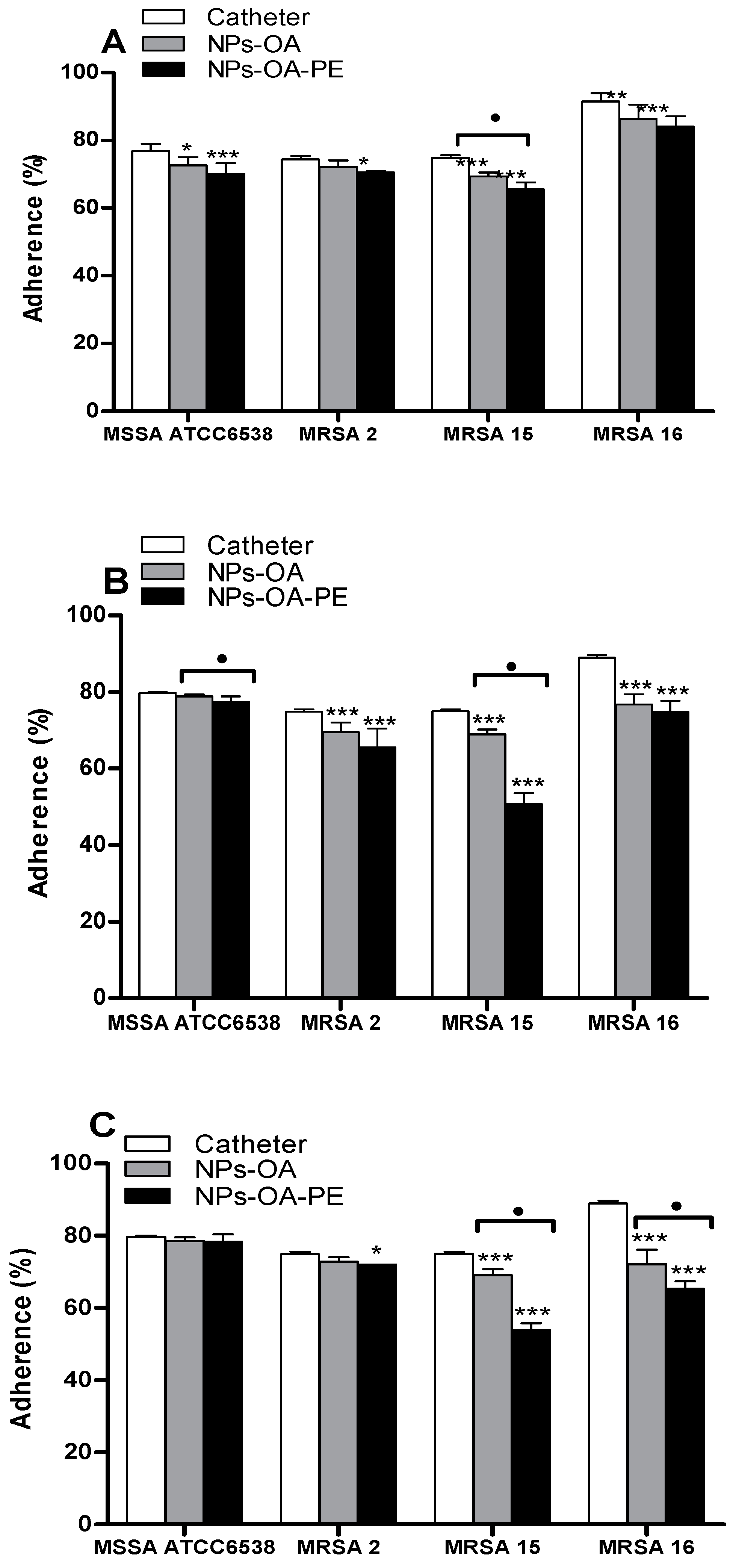
| Sample | Sample Extraction/Compounds | Strains | MIC * (mg/mL); MBC ** (mg/mL) | Major Compounds | Ref. |
|---|---|---|---|---|---|
| Twenty-four batches of propolis collected over two years (2010 and 2011) from different places in France | 1. Methanol (MeOH) | Six human pathogenic bacterial strains collected by the Laboratory of Bacteriology at the University Hospital, Center of Angers, France) | 0.090–>0.100; - | Pinobanksin-3-acetate, pinocembrin, chrysin, galangin, prenyl caffeate | [17] |
| 2. Dichloromethane (DCM) | The same reported above | 0.057–0.097; - | The same reported above | ||
| 3. Mixture of DCM, MeOH, H2O (31/19/4) | The same reported above | 0.030; > 0.100 | The same reported above | ||
| Pinobanksin-3-acetate | MRSA (0706C0025) MRSA (0702E0196) | >0.100; - >0.100; - | |||
| Pinocembrin | MRSA (0706C0025) MRSA (0702E0196) | >0.100; - >0.100; - | |||
| Chrysin | MRSA (0706C0025) MRSA (0702E0196) | >0.100; - >0.100; - | |||
| Galangin | MRSA (0706C0025) MRSA (0702E0196) | >0.100; - >0.100; - | |||
| Prenyl caffeate | MRSA (0706C0025) MRSA (0702E0196) | 0.070; - 0.070; - | |||
| Propolis, collected at Moravia, Czech Republic | Special propolis extract GH2002 (see the reference for the extraction method) | Ten strains | 0.13–0.25; 0.5–1 | - | [18] |
| Propolis samples from an apiary in Kamianna near Nowy Sącz in Southern Poland | Hydro-alcoholic (70%) extract of propolis | Five strains from blood clinical origin MRSA ATCC 43300 | 0.39–0.78; 0.78–3.13; 0.78; 3.13 | Pinocembrin, kaempferol, galangin, chrysin, apigenin, quercetin, gallic acid, ferullic acid, caffeic acid, caffeic acid phenethyl ester, p-coumaric acid and cinnamic acid | [10] |
| The crude propolis and their respective ethanol extracts were sourced from the city of União da Vitória, -State of Paraná, Brazil, provided by Novo Mel® | Ethanol extracts | Strains (clinical isolate) were obtained from the Bacterial Library of the Microbiology Laboratory, Department of Pathology, Santa Casa de São Paulo, -School of Medical Sciences | 1.42 | 3-[4-Hydroxy-3-(oxobutyl)-phenylacrylic acid; 3-prenyl-3(E)-(4-hydroxy-3-methyl-2-butenol)-5-prenylcinnamic acid; 3-prenyl-4-(2-methylpropionyloxi)cinnamic acid; 3-prenyl-4-dihydrocynamoiloxi-cinnamic acid; dihydrokaemferide; 3-prenyl-4-hydroxycinnamic acid, caffeic acid; caffeoylquinic acid 1; caffeoylquinic acid 2; caffeoylquinic acid 3; caffeoylquinic acid 4; caffeoylquinic acid 5; cinnamic acid; p-coumaric acid; kaempferide; kaempferol; betuletol; 2,2-dimethyl-6-carboxyethenyl-2H-1-benzopirane; 2,2-dimethyl-8-prenyl-2H-1-benzopirano-6-propenoic acid; (E)-3-{4-hydroxy-3-[(E)-4-(2,3)-dihydrocynamoiloxi-3-methyl-2-butenyl]-5-renylphenyl-2-propenoic acid; 3,4-dihydroxy-5-prenyl-cinnamic acid; 3,5-diprenyl-4-hydroxy-cinnamic acid | [19] |
| Two Jordanian propolis samples from two locations: University of Jordan (Type I), and Al-Hashmeah (Type II) | Type I crude aqueous methanol extracts Type II crude aqueous methanol extracts Pinobanksin-3-O-acetate Pinocembrin | MRSA isolated from hospitalized patients at the Jordan University | 4.69 | - | [20] |
| Type II crude aqueous methanol extracts | The same reported above | 18.75 | |||
| Pinobanksin-3-O-acetate Pinocembrin | 0.25; 0.25 | ||||
| The propolis was from Guadalcanal Province (The Solomon Islands) for BeeVital & Herbal Apothecary (Withby, UK) ‘Pacific propolis’ | Propolis extracted with 95% ethyl alcohol (EEP). A portion of EEP suspended in water/ethanol (10/1) was partitioned between n-hexane (HEX), ethyl acetate (EA), n-BuOH (BUT) and water (WAT). EA (1-16) fractions obtained from EA fractionated by gel fi ltration using Sephadex® LH-20-100 | One hundred and twenty clinical MRSA isolates were collected from the clinical laboratories of the New Royal Infirmary (Edinburgh, UK) | EEP: 0.064–0.128; - HEX: 0.512; - EA: 0.064–0.128 BUT: 0.128–0.256 WAT: >0.512 EA 9–EA 15: 0.016–0.064 | Prenylflavanones: propolin H, propolin G, propolin D, propolin C | [21] |
| Purchased as ethanolic extract | Ethanolic extract of propolis (P8904, EEP, pH 7.3, Sigma, St. Louis, MO, USA) | MRSA (ATCC 33591) | 1.024; - Propolis plus mupirocin for treating nares of the rabbits infected by MRSA resulted in more profound reduction in bacterial cell count and inflammatory response compared with the rest of the treatment modalities without this conjugation | - | [22] |
| Three samples of propolis were obtained from Croatia: sample 5587 (Zagreb) and samples 5582 and 5581 (Imotski) | Hydro-alcoholic extract (80%) of propolis (EEP), Galangin | Ten strains of MRSA | Sample 5587: 1.06; 2.00 Sample 5582: 4.98; 9.37 Sample 5581: 1.19; 2.37 Galangin: 0.16; 0.27 | Flavones, flavonols, flavanones, galangin | [23] |
| Aromatic Acids | % | Phenolic Acid Esters | % | Flavonoids | % | Diterpenes | % | Sugars and Sugar Derivatives | % | Fatty Acids | % |
|---|---|---|---|---|---|---|---|---|---|---|---|
| Benzoic acid | 0.4 | Pentenyl p-coumarate | 0.7 | Pinostrobin chalcone | 2.7 | Ferruginol | 1.2 | Monosaccharides | 0.4 | Hexadecanoic acid | - |
| Hidroxybenzoic acid | 0.1 | Isopentenyl caffeate | 1.8 | Pinocembrin chalcone | 5.9 | Communic acid | 2.7 | Disaccharides | - | Octadecanoic acid | 1.0 |
| Cinnamic acid | 0.3 | Pentenyl caffeate | 0.9 | Pinocembrin | 7.4 | Totarol | 1.1 | Glycerol | 0.1 | Octadecenoic acid | 0.5 |
| p-Coumaric acid | 0.3 | Dimethylallyl caffeate | 1.2 | Pinobanksin | 3.6 | Imbricataloic acid | 3.2 | Inositol | Tr | Tetracosanoic acid | - |
| Dimethoxycinnamic acid | 0.6 | Pentenyl ferulate | 0.9 | Pinobanksin 3-O-acetate | 3.4 | 13-epi-Cupressic acid | 2.2 | Total | 0.5 | Total | 1.5 |
| Ferulic acid | 0.4 | Benzyl ferulate | 1.7 | Galangin | 5.3 | Ferruginolon | 1.2 | ||||
| Isoferulic acid | 0.4 | Benzyl p-coumarate | 1.3 | Chrysin | 3.6 | Dehydroabietic acid | Tr | ||||
| Caffeic acid | 0.8 | Benzyl caffeate | 4.7 | Total | 31.9 | Isocupressic acid | 8.1 | ||||
| Total | 3.3 | Caffeic acid phenetyl ester | 1.7 | Junicedric acid | 1.8 | ||||||
| Cinnamyl ferulate | 0.4 | Total | 21.5 | ||||||||
| Cinnamyl caffeate | 1.2 | ||||||||||
| Total | 16.5 | ||||||||||
| Standard deviation does not succeed 6% for any of the constituents | |||||||||||
| Bacteria | Origin | Source |
|---|---|---|
| Staphylococcus aureus ATCC 6538 (MSSA ATCC 6538) | Wound | American Type Culture Collection |
| Staphylococcus aureus methicillin-resistant 2 (MRSA 2) | Clinical | UAlg, CBMR. Portugal |
| Staphylococcus aureus methicillin-resistant 15 (MRSA 15) | Clinical | UAlg, CBMR. Portugal |
| Staphylococcus aureus methicillin-resistant 16 (MRSA 16) | Clinical | UAlg, CBMR. Portugal |
© 2016 by the authors. Licensee MDPI, Basel, Switzerland. This article is an open access article distributed under the terms and conditions of the Creative Commons Attribution (CC-BY) license ( http://creativecommons.org/licenses/by/4.0/).
Share and Cite
El-Guendouz, S.; Aazza, S.; Lyoussi, B.; Bankova, V.; Lourenço, J.P.; Costa, A.M.R.; Mariano, J.F.; Miguel, M.G.; Faleiro, M.L. Impact of Biohybrid Magnetite Nanoparticles and Moroccan Propolis on Adherence of Methicillin Resistant Strains of Staphylococcus aureus. Molecules 2016, 21, 1208. https://doi.org/10.3390/molecules21091208
El-Guendouz S, Aazza S, Lyoussi B, Bankova V, Lourenço JP, Costa AMR, Mariano JF, Miguel MG, Faleiro ML. Impact of Biohybrid Magnetite Nanoparticles and Moroccan Propolis on Adherence of Methicillin Resistant Strains of Staphylococcus aureus. Molecules. 2016; 21(9):1208. https://doi.org/10.3390/molecules21091208
Chicago/Turabian StyleEl-Guendouz, Soukaina, Smail Aazza, Badiaa Lyoussi, Vassya Bankova, João P. Lourenço, Ana M. Rosa Costa, José F. Mariano, Maria G. Miguel, and Maria L. Faleiro. 2016. "Impact of Biohybrid Magnetite Nanoparticles and Moroccan Propolis on Adherence of Methicillin Resistant Strains of Staphylococcus aureus" Molecules 21, no. 9: 1208. https://doi.org/10.3390/molecules21091208
APA StyleEl-Guendouz, S., Aazza, S., Lyoussi, B., Bankova, V., Lourenço, J. P., Costa, A. M. R., Mariano, J. F., Miguel, M. G., & Faleiro, M. L. (2016). Impact of Biohybrid Magnetite Nanoparticles and Moroccan Propolis on Adherence of Methicillin Resistant Strains of Staphylococcus aureus. Molecules, 21(9), 1208. https://doi.org/10.3390/molecules21091208








